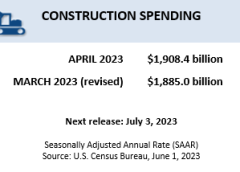According to the U.S. Census Bureau, construction spending during April 2023 was estimated at a seasonally adjusted annual rate of $1,908.4 billion, 1.2% (±0.7%) above the revised March estimate of $1,885.0 billion.
The April figure is 7.2% (±1.2%) above the April 2022 estimate of $1,780.9 billion. During the first four months of this year, construction spending amounted to $566.7 billion, 6.1% (±1.0%) above the $533.9 billion for the same period in 2022.
In April, the estimated seasonally adjusted annual rate of public construction spending was $407.7 billion, 1.1% (±1.2%) above the revised March estimate of $403.4 billion.
- Highway construction was at a seasonally adjusted annual rate of $124.7 billion, 1.3% (±3.5%) above the revised March estimate of $123.1 billion.
- Educational construction was at a seasonally adjusted annual rate of $88.3 billion, 0.1% (±1.8%) below the revised March estimate of $88.4 billion.
Spending on private construction was at a seasonally adjusted annual rate of $1,500.7 billion, 1.3% (±0.3%) above the revised March estimate of $1,481.6 billion.
- Residential construction was at a seasonally adjusted annual rate of $845.4 billion in April, 0.5% (±1.3%) above the revised March estimate of $841.6 billion.
- Nonresidential construction was at a seasonally adjusted annual rate of $655.3 billion in April, 2.4% (±0.3%) above the revised March estimate of $640.0 billion.
“Today’s report shows there has been no letup in most categories of construction despite worries about tighter credit and a possible slowdown in the broader economy,” said Ken Simonson, Associated General Contractors of America (AGC) chief economist. “The top concern for most contractors is finding qualified workers, not projects to bid on.”
Association officials urged members of Congress and the Biden administration to work together to boost investments in construction training and education programs. They noted that construction careers pay well above the average job. They also urged federal officials to enact immigration reforms that will allow more people to lawfully enter the country and work in construction.
“It is encouraging to see growing public and private sector demand for construction,” said Stephen E. Sandherr, the association’s chief executive officer. “Federal officials can help make sure workers are prepared to take advantage of the many high-paying opportunities available to them in the construction sector.”
Spending strength was broad-based, rising in 13 of the 16 nonresidential subcategories on a monthly basis. Private nonresidential spending was up 2.4% in April, while public nonresidential construction spending was up 1.1%.
“What recession?” said Associated Builders and Contractors (ABC) Chief Economist Anirban Basu. “Despite a slew of headwinds, including higher interest rates, prominent bank failures, a near-miss debt ceiling crisis and pervasive fears of recession, money continues to flow into the U.S. nonresidential construction segment. Manufacturing-related construction spending growth continues to lead the way, but even segments that had been weak such as lodging are picking up steam.
“Contractors continue to complain about labor and skills shortages in the context of strong demand for their services,” said Basu. “It appears that the optimism that ABC contractors have been expressing about their prospects is proving justified. Backlog is stable and there is still evidence of significant pricing power, helping to support contractor profit margins. Moreover, public construction spending stands to remain strong even if the economy enters recession later this year, with considerable sums of money lined up to drive road, bridge and other work during the years ahead.
“While 2023 appears to be a solid year of growth for the nonresidential construction industry, 2024 remains far less certain,” said Basu. “The combined impacts of growing weakness in consumer spending, tightening credit conditions, lag effects associated with prior Federal Reserve rate increases and uncertainty stemming from high-stakes elections could eventually catch up to the broader economy and certain construction segments.”

